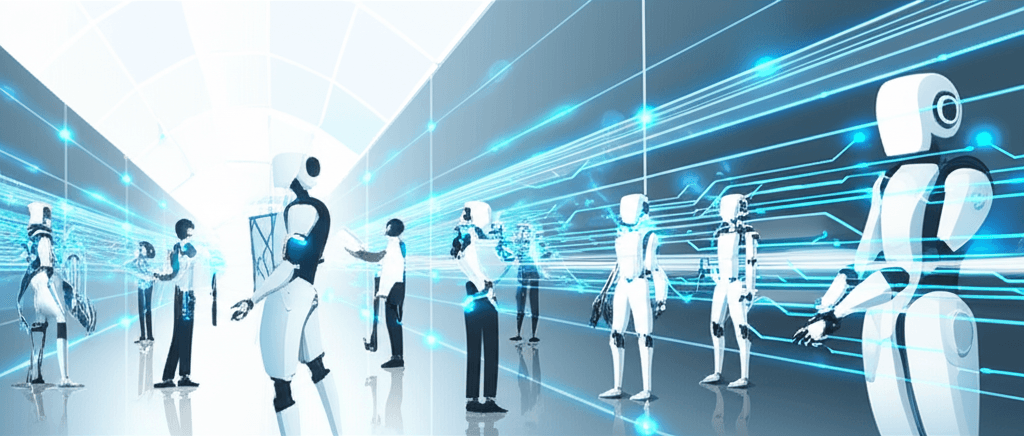Embodied AI Sparks New Era: Robotic Co-workers Reshape Global Industries
Embodied AI is unleashing intelligent robots, creating a $370 billion market, and redefining human-robot collaboration.
July 10, 2025

A new era of workplace collaboration is dawning, powered by the fusion of advanced artificial intelligence and sophisticated robotics. This burgeoning field, known as embodied AI, is poised to unleash a new generation of robotic co-workers, transforming industries and reshaping the global economic landscape. According to a recent report by the McKinsey Global Institute, the market for general-purpose robotics, a key segment of embodied AI, could reach approximately $370 billion by 2040.[1] This technology, which integrates AI into physical systems, allows robots to perceive, learn from, and interact with the physical world in a dynamic and adaptive manner, moving beyond single, pre-programmed tasks.[1][2][3] The implications are vast, promising to enhance productivity, mitigate labor shortages, and create new economic opportunities, all while presenting complex challenges for businesses and the workforce.[4][5]
At its core, embodied AI gives a physical "body" to artificial intelligence, enabling it to perform actions in the real world.[1] Unlike traditional AI models that exist in virtual environments, embodied AI systems learn through direct physical engagement, much like humans do.[3] This is made possible by breakthroughs in vision-language-action (VLA) foundation models, which function as the "brains" for these robots, allowing them to understand and respond to their environment and even follow verbal commands.[1] Recent advancements have led to the development of humanoids and other general-purpose robots capable of natural movement, object manipulation, and performing actual jobs in real-world settings.[6] These robots, often referred to as "cobots," are designed to work safely alongside humans, equipped with improved sensors and programmable force limits to minimize risks.[1] The goal is not necessarily to replace human workers, but to augment their capabilities, taking over tasks that are tedious, difficult, or dangerous.[1][7] This human-robot collaboration is expected to drive efficiency and productivity across numerous sectors, from manufacturing and logistics to healthcare and agriculture.[8][5][9]
The economic potential of this technological shift is massive, with projections pointing to a significant and rapidly growing market. The McKinsey Global Institute's base case scenario forecasts a general-purpose robotics market of around $370 billion by 2040, a figure that hinges on moderate progress in key areas like training data, hardware affordability, and organizational adoption.[1] Investment in the sector is already surging, with funding for general-purpose robotics growing fivefold from 2022 to 2024, exceeding $1 billion annually.[1] This influx of capital is fueling innovation at startups and established tech firms alike. The decreasing cost of components, a trend accelerated by advancements in the electric vehicle industry, is also making these sophisticated machines more commercially viable.[10][11] The manufacturing cost of humanoid robots, for instance, has seen a significant drop, making them a more attractive proposition for a wider range of industries.[11]
A significant portion of this burgeoning market is expected to be dominated by China. The country has declared embodied AI a national priority and is backing this ambition with substantial financial commitment, including a $138 billion innovation fund.[1] This state-guided approach allows for the streamlined integration of research, development, regulation, and supply chain scaling, potentially accelerating the path from prototype to mass-market deployment at an unprecedented speed.[12] China already possesses a complete industrial chain for manufacturing humanoid robots and leverages its advanced manufacturing ecosystem to produce high-quality robotics at competitive costs.[13][14] As a result, China currently commands a substantial share of the global embodied AI market, with some reports indicating it captures as much as 70%.[13][14] This dominance is further bolstered by a deep talent pool in AI and a flourishing domestic market for automation, driven by factors like a large manufacturing base and a desire to offset a declining workforce.[10][15] Projections suggest that around 50% of the $370 billion general-purpose robotics market in 2040 could come from China.[1]
In conclusion, the rise of embodied AI signals a transformative period for both the technology industry and the global workforce. The development of intelligent, adaptable robots that can work alongside people promises to unlock significant productivity gains and address pressing labor challenges. While uncertainties about the exact timeline and pace of adoption remain, the trajectory is clear: the integration of AI into physical robotics is creating a powerful new economic frontier.[1] The substantial market projections, coupled with the intense investment and strategic focus from nations like China, underscore the immense potential of this technology. As businesses prepare for this new wave of automation, the focus will be on harnessing the collaborative power of human and robotic workers, navigating the complexities of implementation, and preparing for a future where intelligent machines are an integral part of daily operations.[1][8]